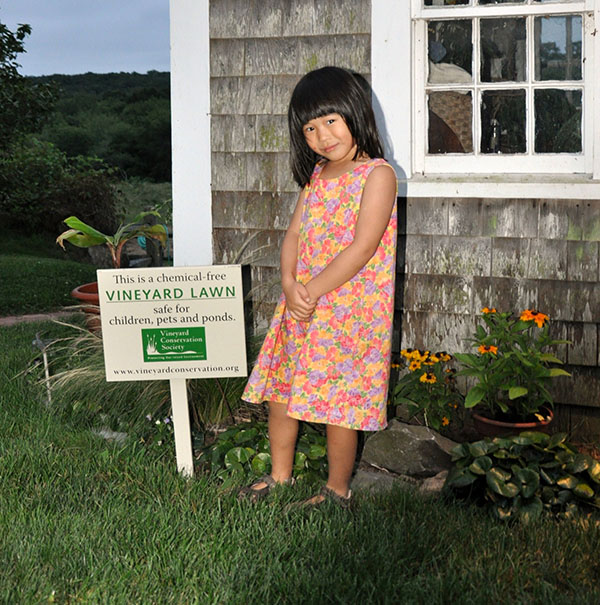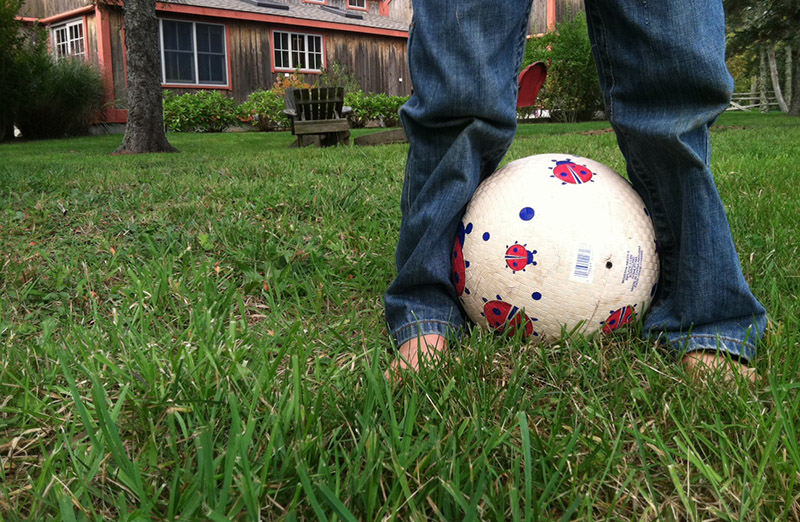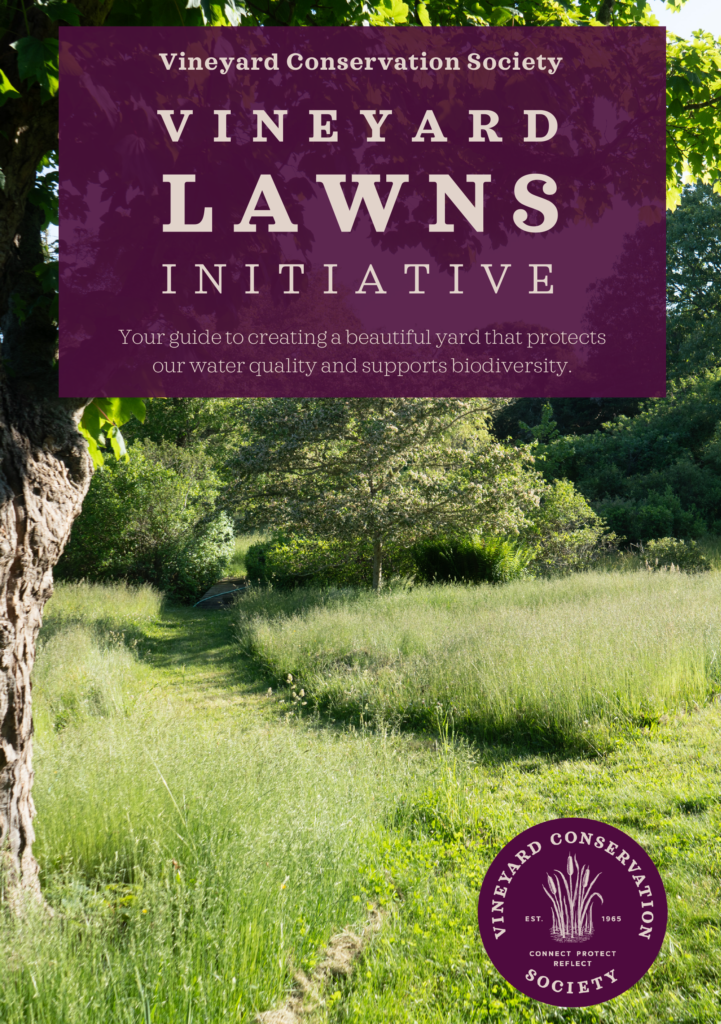Vineyard Lawns
For those who love the Vineyard and call it home (or home-away-from-home), part of the unique charm of the island is the very fact that it doesn’t look like everywhere else. A large reason for that is natural history: the island’s glacial history, the ecosystems that evolved within it, and the large amount of conserved habitat that allows those species to flourish. However, another important difference can be found in the human environment – in particular, the land right next to our houses.

The ubiquitous suburban lawn – that emerald green, weed-free monoculture – has never been the ideal here. In fact, for many of us, it’s not even desirable. Instead of seeing a safe and inviting extension of our homes, we’re thinking of downstream consequences of chemical perfection. The fertilizers used for monoculture turf contribute significantly to the nitrogen pollution that has our coastal ponds frequently closed to swimming and shellfishing. The pesticides and herbicides used to kill bugs and weeds also kill native biodiversity and threaten our drinking water. Even the watering needed to keep a lawn artificially green in summer is a sad waste of groundwater during the most droughty season.
Luckily there’s a better alternative: the Vineyard Lawn, which uses no pesticides, no chemical fertilizers, and only occasional watering if truly necessary. Mixed grass varieties and native plantings are hardier, better adapted to local conditions, and require less time and attention. And a Vineyard Lawn will always be safe for kids, pets, and wildlife – no need to check product labels and Google for the latest news on potential health effects.
In contrast to the ecological dead zone of an artificially maintained monoculture lawn, your Vineyard Lawn will be a host to a wide diversity of grasses and wildflowers. Have you ever looked closely at the flowers of so-called weeds? Their shapes, colors, and textures are beautiful – and left alone to flower and set seed naturally, they’ll provide habitat and forage for butterflies, bees, and other pollinators. The Island wildlife will thank you for sharing your Vineyard Lawn!
Ready to learn more and get started? Download the new brochure for strategies and tips on creating your own Vineyard Lawn.
Seed Selection
- Choose a grass seed blend that is compatible with the Vineyard’s natural environment. Perennial ryegrass and fine or tall fescues are good; avoid bluegrass, which is fussy to grow, requiring more nitrogen and water.
- One good option available locally is Jonathan Greene Black Beauty, Heavy Traffic mix, carried by S.B.S. and possibly other retailers.
- Another good choice, actually developed for Cape Cod, is the Harmony mix from Colonial Seed, available online at Agway Cape Cod and Lavoie Hortiulture (and probably elsewhere).
Lawn Care Tips
- Use the highest deck setting on your lawnmower, never removing more than a third of the shoot growth per mowing.
- Don’t bag grass clippings. Set the mower to “mulch” and leave them where they fall; the clippings are a natural source of slow-acting nitrogen fertilizer and protect against drought.
- Topdress the lawn each spring by adding 1⁄4” to 1⁄2” of loam, until soil is 6” deep. This will help reduce nitrogen leaching into the groundwater.
- Once the topsoil is well established, consider adding another 1⁄4” of compost each spring.
- Test your soil’s acidity and add lime if you need to bring the pH up to 6.5. This will help the grass make better use of the nitrogen that is naturally in the soil.
- Don’t overwater – it’s unhealthy for the grass, but also increases nutrient runoff.
- Pull weeds by hand instead of using chemical herbicides.
- Finally, the simplest but most important of all: Reduce the amount of lawn area in favor of low-maintenance plantings, gardens, and native vegetation.

Attention Neighborhood & Road Associations!
Are you interested in having VCS bring the Vineyard Lawns message directly to your neighborhood/road/homeowners association? If so, please contact us. We are happy to work on setting up a presentation for your members, and we have flyers and other materials to share if we can’t be there in person.
Are you ready to make the No Fertilizer Pledge?
Click here to learn more and sign on!
Lawn Fertilizer Regulations
The excessive use of fertilizer is the second greatest source (after wastewater) of the nitrogen pollution that threatens the health of our Island’s coastal ponds1. While responsible fertilizer use is essential to our Island’s agricultural tradition, curtailing the heavy inputs of nitrogen deployed in pursuit of suburban-style monoculture lawns represents one of the best “low hanging fruits” for restoring our critically imperiled ponds.
The bylaw, intended to protect our waters by reducing nutrient pollution, was created by the MV Boards of Health incorporating input from the MV Commission, other elected officials, local landscapers, golf course managers, UMass Extension scientists, and many members of the community, including VCS. While the new rules are thorough and well-considered, and not especially onerous in what they restrict, they are also not necessarily simple to understand for the average homeowner.
That’s why, during the 2014 Town Meetings, voters of all six Island towns approved a new bylaw that would regulate the sale and use of lawn fertilizer. Importantly, the regulations apply to everyone – homeowners as well as professional lawn care companies.
Therefore, to help spread the word about how to comply with the new bylaw while maintaining a healthy, non-polluting lawn, VCS has prepared an informational brochure. Look for it in Island garden supply stores, or check it out online. Also, please do let us know if you would be interested in helping spread the word around your neighborhood; we can provide as many copies of the printed brochure as you need.
But wait! Didn’t you just say “no chemical fertilizers at all?”
At VCS, our dream would be to see a Vineyard Lawn replace every single monoculture lawn across the Island, and that will continue to be the focus of our advocacy. But we recognize that ideal remains a long way off. Support for the Boards of Health’s efforts to regulate and limit fertilizer use is an essential step in getting there, as well as a powerful move toward addressing nitrogen pollution today.
Resources
Vineyard Lawns brochure
Background on the Vineyard Lawns program and a variety of useful tips and other into can be found in our brand new brochure. Download it here, or for a hard copy stop by the Wakeman Center and see us (or Contact Us and we’ll mail it to you!).
MV CYANO
This handy data-visualization resource from Great Pond Foundation provides at-a-glance information on the likelihood of dangerous cyanobacteria blooms. The data presented is the result of GPF’s water quality monitoring work.
Landscaper & Homeowner Surveys
As part of their “Forgo Fertilizer, Protect Ponds” initiative, Great Pond Foundation is collecting information from Island landscapers, as well as riparian homeowners. Click here to learn more about the impact of fertilizer and take the survey.
Popular articles, Outside info & more
Why Mow? The Case Against Lawns (by Michael Pollan for NY Times Magazine)
Turf War (by Elizabeth Kolbert for The New Yorker)
PlantFinder Excellent local info from the Polly Hill Arboretum
Lawn Maintenance and Climate Change (Princeton Student Climate Initiative)
Best Ground Covers as Grass Alternatives (Lawn Love)
A Lush Lawn Without Pesticides (Consumer Reports)
- A study led by scientists at the Marine Biological Laboratory in Woods Hole, with support from Great Pond Foundation, found that the largest contributors of nitrogen to our coastal ponds are, in descending order, wastewater, fertilizer, and atmospheric deposition. Read the original study here. ↩︎

